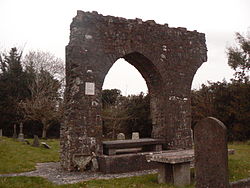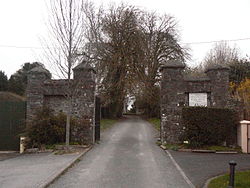Dunshaughlin
| Dunshaughlin Irish: Dún Seachlainn | |
| Meath | |
|---|---|
 Remains of the monastic site of Saint Seachnall | |
| Location | |
| Grid reference: | N965526 |
| Location: | 53°30’42"N, 6°32’22"W |
| Data | |
| Population: | 5,840 (2016) |
| Post town: | Dunshaughlin |
| Postcode: | A85 |
| Local Government | |
| Council: | Meath |
Dunshaughlin is a town in Meath. The name is from the Irish Dún Seachlainn meaning 'Seachlann's fort', although there are no records of a fort here.[1] An alternative name used in ecclesastical records is Domhnach Seachnaill meaning 'St Seachnall's Church'.[2]
History

It is named for Saint Seachnall, who established a church there in the 5th century. The oldest reference to the place name is an entry in the Annála Uladh from the year 801, where the name takes the form "Domnaig Sechnaill". The word "Domnach", used in this way, can be attributed to churches which originate from the beginnings of Christianity in Ireland. [3]
Máel Sechnaill mac Domnaill was an ancestor from which the principal family of Brega, Ó Maoilsheachlainn, is descended. Dunshaughlin (or more specifically, the townland of Lagore) is famous for an ancient crannóg or settlement from the 7th century where a number of antiquities were discovered. Approximately a mile south of the village is a preserved workhouse from the time of the Great Famine which was abolished in the early 1920s; it is currently under private ownership and not open to the public.
Today
Dunshaughlin is 29 km from Dublin on the R147, formerly the N3 road but renamed after the M3 was opened. It is a growing satellite town of the Dublin. It has grown considerably over the last 20 years, the population in 1996 was 2,139, it was 3,063 by the census of 2002 and had risen to 3,384 by 2006. Most recently in 2016 the population reached 5,840. Several housing estates centre on a main street with multiple retail units consisting of newsagents, pubs, take away food outlets, clothing stores and banks. There is also a business park on the outskirts of the town.
Dunshaughlin houses numerous public amenities, including a library, a health centre and the Meath County Council civic offices. A large community and sports centre was opened in the grounds of Dunshaughlin Community College in the year 2000. The centre is operated by a voluntary board of management.[4]
Education
Dunshaughlin has two primary schools; Gaelscoil na Ríthe and St. Seachnall's. It also has one secondary school; Dunshaughlin Community College (DCC). DCC was established in 1933 and is part of the Louth and Meath Education and Training Board and is a co-educational school. Construction was completed on an extension at the school in 2013 and the extension was opened on 29 November 2014.[5][6]
In 1985 a group of parents from the Dunshaughlin, Drumree and Culmullen areas set about providing All-Irish education for their young children. As a result, Gaelscoil na Ríthe was established. The school enjoyed sustained growth over the years with a new building provided in 1996. At present the school caters for a full stream of eight classes, over 200 pupils and has 12 teaching staff.[7]
St Seachnall's was founded in 1835. It now has around 500 students (boys and girls) attending the school.[8]
In 2013 a new building was complete to cater for the growing number of students attending the school.[9]
Public transport
Dunshaughlin is served by Bus Éireann commuter services to Dublin, generally running at a frequency of every half-hour, with plans to increase frequency to every 15 minutes.[10] Subject to the reopening of the Dublin–Navan railway line, there is a new station planned.
Sport
The town is represented in sport by a Men's & Ladies Gaelic football team. The Men's team were Meath county champions 3 years in a row from 2000-2003. Their main sponsor is the local supermarket, SuperValu Dunshaughlin. The local association football club is Dunshaughlin Youths[11], a club active both in the local community and in the North Dublin Schoolboys league.[12]
Basketball is a growing sport in the community. The local club, Dunshaughlin Rockets, have seen much success in recent years competing in both the North East Basketball League and the Dublin Ladies Basketball League. Dunshaughlin community college has won both a girl's u16 All-Ireland title, a second year girl's All-Ireland a boy's u19 All-Ireland title.[13]
Dunshaughlin Athletic Club is traditionally considered a long-distance running club. However, the club has enjoyed the success of many juvenile sprinters of late, who have excelled at county, regional and national level. The town's golfing community takes great pride in its golf course "The Black Bush Golf Club". Around two miles outside the village a new golfing resort designed by Jack Nicklaus has been created at Killeen Castle. The course hosted the 2011 Solheim Cup despite it not opening until 2008.
The town also has a strong association with horse racing, in particular National Hunt racing. The leading flat race sprinter Sole Power, winner of the Nunthorpe Stakes and the King's Stand Stakes, is trained near the town by Edward Lynam.[14] The Dunshaughlin and District Road Racing Supporters Club are a club of like minded motorcycle racing enthusiasts who provide and support a racing machine for the Irish road race championship.
The Workhouse
The Dunshaughlin workhouse was erected in 1840-41 on a five-acre site a mile and a half to the south of Dunshaughlin, the building was planned to accommodate 400 inmates. Its construction cost £4,938 plus £912 for fittings etc. The building was declared fit for habitation on 12 May 1841, and received its first admissions on 17 May.
During the Irish Famine in the mid-1840s, many hundreds of people were crowded into the stone building in dreadful conditions. A burial ground was located to the rear of the workhouse, which you can still visit today, sometimes memorial services are conducted here for those who died during the famine.
In the post-famine years, the workhouse rarely had more than a few dozen inmates. During the First World War, the building was used to accommodate Belgian refugees, some of whom died there and were buried in the paupers' graveyard. In 1920-21, the building was taken over as a barracks by the Black and Tans during the Irish War of Independence.
Following the creation of the Irish Free State in 1922, the workhouse system was abolished. After many years of vacancy and semi dereliction the main building was taken into private ownership in the 1990s and now is primarily a private residence.
Dunshaughlin Harvest Festival
Dunshaughlin Harvest Festival is a three day festival, usually taking place towards the end of September. The festival has exhibitions with music, drama, dance, heritage events, food & craft markets, country sports and old-fashioned games for the children. As well as all the festivities, a harvest Queen is elected to be the face of the festival.
References
- ↑ "Logainm: Dunshaughlin". Placenames Database of Ireland. http://www.logainm.ie/ga/1416707?s=Dunshaughlin. Retrieved 16 March 2015.
- ↑ While Domhnach Seachnaill remains the common name among the natives, since the Placenames Order, 1975 the alternative recorded Irish name for the town, Dún Seachlainn, is designated as the official name. Both names are equally legitimate with Domhnach Seachnaill appearing in ecclesiastical records and Dún Seachlainn appearing in secular records.
- ↑ "Dún Seachlainn/Dunshaughlin". 25 May 2017. https://www.logainm.ie/ga/1860. Retrieved 20 August 2017.
- ↑ "About us - Dunshaughlin Community Centre Ltd". http://www.dunshaughlincommunitycentre.ie/about.html. Retrieved 20 August 2017.
- ↑ "Extension open date". http://louthmeath.etb.ie/latest-news/dunshaughlin-community-college-extension-officially-opened. Retrieved 30 June 2017.
- ↑ "Welcome". http://dunshaughlincc.ie. Retrieved 20 August 2017.
- ↑ "History – Gaelscoil Na Ríthe". http://gaelscoilnarithe.ie/?page_id=97&lang=en. Retrieved 2 December 2016.
- ↑ "General Info". http://www.stseachnalls.ie/general-info.html. Retrieved 2 December 2016.
- ↑ "Principal Message". http://dunshaughlincc.ie/index.php/our-school/principal-message. Retrieved 5 December 2016.
- ↑ "Bus Éireann News". 25 April 2007. http://www.buseireann.ie/news.php?id=534&month=Apr. Retrieved 20 August 2017.
- ↑ "DUNSHAUGHLIN YOUTHS FC". http://www.dyfc.ie. Retrieved 21 August 2017.
- ↑ "Welcome to North Dublin Schoolboys/Girls League". http://www.ndsl.ie. Retrieved 2017-08-21.
- ↑ "Basketball Club". Dunshaughlin Rockets. http://dunshaughlinrockets.com. Retrieved 20 August 2017.
- ↑ "Edward Lynam". Racing Post. http://www.racingpost.com/horses/trainer_home.sd?trainer_id=3238#topTrainerTabs=trainer_big_race_wins&bottomTrainerTabs=trainer_big_race_wins. Retrieved 20 August 2017.
Outside links
| ("Wikimedia Commons" has material about Dunshaughlin) |
